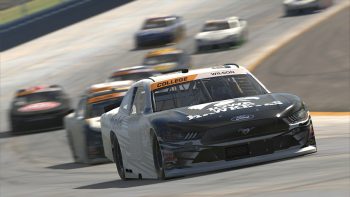
NASCAR iRacing Series Open Garage: Dover
June 2nd, 2014 by JaimeB
Editor’s note — Technical issues prevented us from posting this edition of the “NiS Open Garage” until after the Dover race week. For that we apologize but also remind one and all that there is plenty of sim-racing on the Monster Mile in the future . . .
Dover possesses a few unique characteristics that make this track a favorite for some and a nemesis for others. Its concrete surface, 26 degree banking combined with a quick bumpy transition to the straights creates a feel some drivers describe as “Landing” on exit. Cars can seem “tight” on entry or to “Push” in the middle only to cut loose on exit without warning, “as if on a light switch” Darrell Waltrip describes it.
The steep banking, big transitions and bumps make Dover a great place to focus on the first topic of this week’s article: shocks. In a previous article we discussed spring adjustments, so it seems sensible that this week we talk about how the shocks work in union with the springs to “smooth” the feel of the car on transitions. Shock adjustments can also help on tracks like Dover where there are bumps on the exit of a turn that can help break the car loose.
Shocks apply force to the suspension only while the suspension is moving on the car. When speaking of shocks “Compression” adds load to a tire while it is being pushed up into the wheel well. “Rebound” takes load from a tire as it is being pushed towards the pavement. “Bump stops” limit the travel of shocks. Shims control the height at which the bump stops bottom out, controlling how much travel is available to the shocks.
How does this information help us? Well in Dover, Softer rear springs combined with a higher rebound rate will help slow the decompression of the shock here allowing the car to maintain that rear “squat” a bit longer on exit making it more controllable on exit. That being said, due to the bumps it will still be bouncy so throttle control on exit will be something you will want to practice.
The second topic of discussion this week is Toe. Toe is the relation of tires to the chassis. Stock cars commonly utilize what is known as a “Non Zero” toe angle. This means that the front wheels are not pointed straight ahead when the car is running straight. A car with Toe-Out (most commonly used in stock car racing) has tires that are angled out at the front, toe in would be tires that are turned in towards the chassis.
Toe-out is used to achieve stability on initial corner turn-in. An eighth of an inch of toe-out is a common starting place while slight adjustments are used to help make adjustments in car control. Consequently, toe (in or out) generates forces in the tires that dissipate some of the car’s forward energy. Toe settings can also help a real car realize stability in cross-winds.
This week in Dover we can use toe to help steer the rear end of the car, helping the “loose off” feeling inherent in the stock setup. Making a small correction will also help compensate for the the 7mph winds which will also make us a tad loose on exit, especially out of Turn Four.
This week I utilized lessons we learned in previous articles as far as lowering the track bar and adjusting the weight distribution along with shock adjustment to help the car in transitions. I also took some camber out of the front left as the tire temps were way out of range. This also helped us lessen wear and gain some control on exit where the car seemed to over rotate.
Unlike last week where we ran at the top of the RPM range, this week we will not run so hot so we can add a bit of tape which will increase our speed in the straights as well as increase down-force. Im running 35% tape but I recommend you experiment by trying to increase your tape in practice and making note of your water and oil temps.
My base setup is available in the NiS Open Garage Forum. You will want to make adjustments in the track bar and tire pressures to tailor the car to your own liking. As usual the setup is loose to start requiring the driver to control the turn with the throttle, however this is especially tricky on exit this week with the tracks inherent instability. You may just want to consider dropping the track bar to tighten it up before you get started and raising it as you find your line and get used to the cars handling.
Good Luck and God Speed!
















































